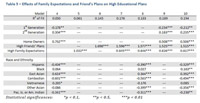Acculturation and the Educational Aspirations of the Children of Immigrants
 A graph showing higher educational aspirations among second generation immigrants.
A graph showing higher educational aspirations among second generation immigrants.
Abstract
America has often been referred to as a melting pot, a nation comprised of people from diverse ethnic and cultural backgrounds whose differences are reduced over time, particularly across generations. Although the melting pot image has only modest empirical support, there was remarkable assimilation of the children and grandchildren of disadvantaged European immigrants who came to the United States in the early 20th Century. The descendants of these immigrants have adopted - and also changed - American culture as they gradually obtained economic success and become part of the mainstream middle-class. In recent decades, new sociological theories have risen to try to explain the much slower process of assimilation experienced by recent immigrants.
A key issue is the relationship between cultural and socioeconomic assimilation. Classical Assimilation Theory argues that cultural assimilation, or acculturation, is generally a prerequisite for positive economic assimilation. The Immigrant Optimism Hypothesis suggests that immigrants usually have a stronger will to succeed than natives and that this advantage can be lost with too much cultural assimilation. Segmented Assimilation theorists take this argument further and argue that in the spatially-segregated nature of the American class structure, most immigrants have more contact with underclass than middle-class culture. Thus, acculturation can have a negative impact on socioeconomic assimilation, perhaps leading to joining the underclass.
In my research, I draw upon these theories to examine the effects of acculturation on the higher educational aspirations and attainment of the children of immigrants relative to comparable youth of native born parents. Using data from the Beyond High School study, conducted by the University of Washington, Department of Sociology, I also examine the effects of peer and parent expectations on the development of college aspirations. The goal of this research is to gain is a clearer understanding of the role of community factors on immigrant assimilation.

